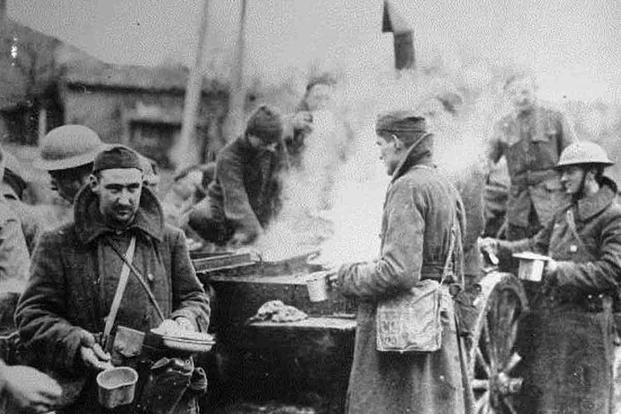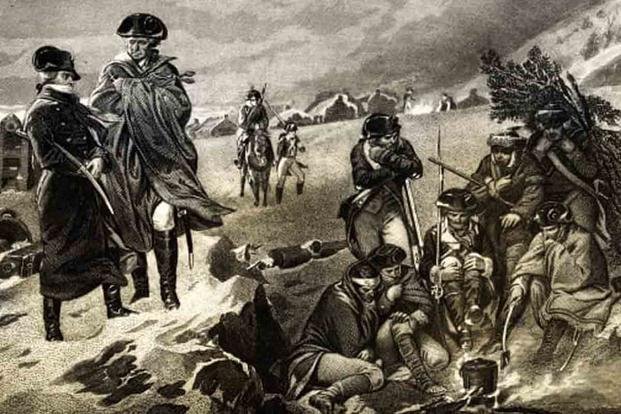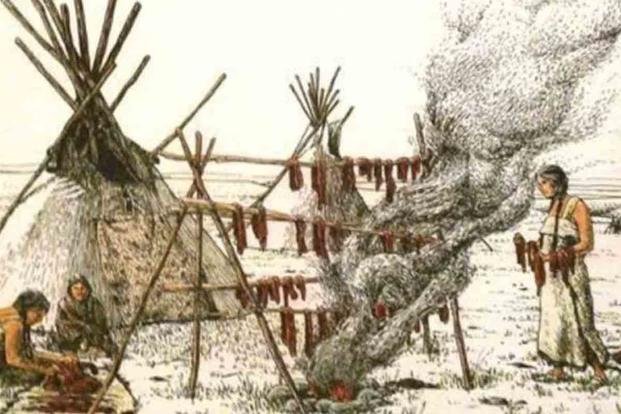
By Blake Stilwell
If an army runs on its stomach, the U.S. military is not only a well-fueled machine, it also has some very firm opinions about what fuel it gets, how the fuel is prepared and whether Tabasco sauce comes in the fuel pouch.
Life wasn’t always jalapeño cheddar packets and chocolate fountains in the Air Force dining facility. In the days before chicken tenders, American troops had it much, much rougher at mealtime. Some of the food that came from U.S. mess halls is still remembered (and sometimes reviled) even 50 years later.
Still, even the most notorious meals helped shape the armed forces, their culture and, in many ways, the United States itself. Here are just a handful of those classics.
1. Creamed Chipped Beef on Toast
The most famous and notorious of all chow hall staples during the 20th century, creamed chipped beef has gone by many names since it first appeared in the 1945 Manual for Navy Cooks. It has as many fans as it has critics, but even those who love it will still refer to its original nickname, “Sh– on a Shingle.”

Today, the recipe calls for lean ground beef instead of dried lunch meat beef, but the simple white sauce is essentially the same milk and fat cream mix, thickened with flour. If you don’t believe that some people loved this dish and still do to this day, just know you can buy it on Amazon.
2. Pepper Pot Soup
U.S. troops who served in Vietnam might be familiar with this mild version of an old spicy vegetable soup classic. The Pepper Pot Soup they knew in Southeast Asia, however, was actually pretty different from the first versions the Army made, which came during the Revolutionary War.
While Gen. George Washington was camped at Valley Forge in 1777, his baker was Christopher Ludwick, who had a lot of experience with desperation, baking for the Austrian Army during the 1742 Siege of Prague and later for the English Royal Navy. He knew how to make rations stretch and to make something improvised seem more palatable.

At Valley Forge, Ludwick scrounged for old potatoes, old meat and whatever vegetables were around to make a soup that could be boiled and made healthy again. To cover the taste of the old stew, he used hot peppers and black peppercorns. “The Pepper Pot” reinvigorated the Continentals and entered the Army field manual for the next 200 years.
3. Cornmeal Mush
Cornmeal Mush might be the most American dish of all time. Early settlers learned to make it from native tribes, who used it for both breakfast and dinner meals. It’s so easy to make, while being filling and adaptable, it’s no wonder cornmeal mush was a staple of the Revolutionary War, the Civil War, the Spanish-American War and World War I.
By the time of the WWI, Army cooks were boiling it and serving it with butter and evaporated milk. Previous versions of the dish included dried and fried strips of mush smothered in maple syrup, bowls of it served with sausage gravy or simply with butter and salt.
4. Pemmican
During the Plains Wars of the last half of the 19th century, American troops had to cover vast distances with smaller numbers, often bringing with them only what they and their horses could carry. When the difference between life and death often meant the ability to return fire, those troops understandably opted to carry more ammunition than food. After all, you can forage for food. Bullets were a lot more difficult to scrounge up.
Pemmican, also known as “jerky,” was the Army’s solution. It required troops to cut the fat off of meat, melt it while pulverizing the meat, then add dried fruit and the melted fat back to the meat before forming it into cakes and drying it in the sun. It kept for a long time, and had the added benefit of not requiring a cooking fire that might give away their position to hostile forces.

5. Slumgullion
Slumgullion, or simply “slum,” was the nickname given to any number of Army cooks’ unofficial stew recipes during World War I. There are no official recipes for how to make it, but the doughboy cooks of the Great War knew how to use every bit of food available, and just how much to water it down to make it last. It often contained beef, onions and canned tomatoes, along with whatever spices and seasonings were free for the taking.
The upsides of slumgullion were that it was always hot, and it always did the job of providing nutrients. Most of the time, there was also plenty of it to go around. These days, you might see slumgullion as a pasta dish, a “leftovers” stew or even “American Goulash.” All you really need to know is that it’s forbidden to eat slum with your bayonet.
6. Salt Pork and Hardtack
If you needed to feed a lot of people for a long time, it was always a good idea to keep your rations from spoiling or going stale. Salt pork was the answer for this problem during the Civil War. And it was just like it sounds: pork preserved in salt. It had to be soaked in fresh water before it became anything close to edible.
The easiest way to keep bread from going bad was to thicken it and cook it until it was so hard, it too needed to be soaked in water before eating. That’s not a joke: That’s what troops had to do. There’s a reason the hardtack — also known as ship’s biscuit in the Navy — was called “sheet iron.”

Salt pork and hardtack bread was a staple of the U.S. military for most of the 19th century, until it went away after the Spanish-American War. Probably the best things about it were that it was guaranteed not to kill you (a problem with a lot of foods) and that it allowed for a lot of improvisation. You could prepare the pork with whatever could be found, while hardtack was often turned to “sloosh” — bread soaked in milk with fruit.





